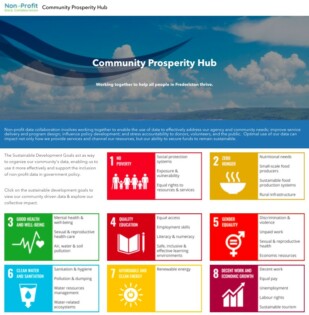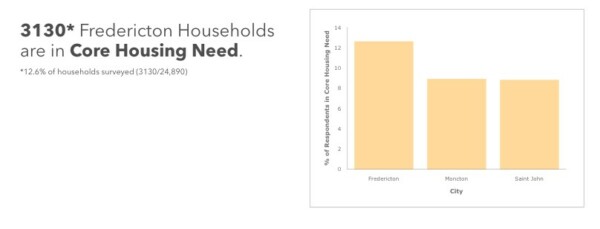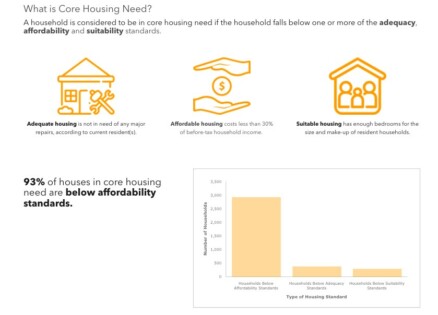
As part of the Nonprofit Data Collaboration project, we have been working with the City of Fredericton to create a Community Prosperity Hub. The Community Prosperity Hub is built on the city’s open data portal. The creation of the hub serves multiple purposes. In the short-term, within the context of the project’s applied research, the hub acts as a probe/catalyst for conversation and reflection on the role of data for NPOs and demonstrates what questions can/can’t be answered with various types and granularity of data. This allows the hub to act as a platform for experimentation and learning. In the long-term, the hub may be positioned to act as a data sharing resource for the broader community.
We have structured the Community Prosperity Hub around the United Nations’ Sustainable Development Goals (SDG). The overall intent and subsequent information architecture for each goals’ space within the hub is to:
- Define the problem(s) being addressed;
- Illustrate how that problem presents itself in our city;
- Highlight the work of local nonprofits whose work may advance our progress towards the goal, and
- Provide access to relevant indicators and resources.
Most recently, we have been working on the Sustainable Cities and Communities Hub, based on the 11th SDG, which is to “make cities and human settlements inclusive, safe, resilient and sustainable”. When we began designing the Sustainable Cities and Communities Hub, we instantly struggled with using data to represent Fredericton’s complex housing landscape. Numbers and percentages, while invaluable in many contexts, do not adequately reflect lived realities.

For example, data shows that in 2021, the average renter in Fredericton was spending no more than 27.52% of their income on housing. This fact alone could make it appear as though affordable housing is not a major concern in the city. However, other data tells us that 12.6% of Fredericton households surveyed report being in core housing need and 93% of these households are experiencing core housing need because they cannot meet the affordability standards.
- “A household is considered to be in core housing need if it meets 2 criteria:
- It is below one or more of the adequacy, suitability, and affordability standards
- The household would have to spend 30% or more of its before-tax household income to access local housing that meets all three standards”
If we presented Fredericton’s averages as a reflection of the entire city, a significant portion of our population would be unrepresented. We decided to take a more narrative-based approach in this hub’s design to ensure that there weren’t any parts of this story left behind.

Our goal for the hub’s main page was to provide a snapshot of Fredericton’s current housing situation. To do this, we first contextualized the problem by providing some basic facts and statistics about core housing need. This section presents affordability as the overarching problem in Fredericton. To expand on the issue of affordability, we explained the housing continuum and grouped its stages into four different categories. Each category is broken down further and includes definitions, as well as a list of organizations in the Fredericton area that offer the services under discussion.
We are attempting to provide as clear an overview of Fredericton’s core housing need as possible, however many areas of ambiguity remain. Some of the data on this issue is outdated and does not reflect the significant changes that occurred within the housing sector with the onset of the pandemic. Other data sources are incomplete and recorded inconsistently across organizations. While the number of households surveyed by Stats Can represents 96% of households in Fredericton, we know that segments of the population, such as individuals experiencing homelessness and numerous minority groups, are often completely left out of the data collection process. Additionally, we have an incomplete list of the various affordable housing spaces that are offered as some of this data is unavailable to the public. Despite these challenges, we did our best to illustrate this complex issue with the data and resources that were available.
In addition to illustrating the problem, we sought to highlight organizations in our community and contextualize the necessity of their work. In doing so we hope to promote awareness, and inter and cross-sector communication and collaboration.
